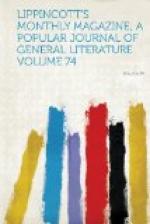The convent of the Assumption at Auteuil, a suburb of Paris, is one renowned for its excellent educational advantages. I spent a week there one winter on a visit to a near relative among the pupils, and had an opportunity to observe the clock-like life of the place. All the girls I have known to be educated there were better scholars than any brought up elsewhere. There were many English and American girls, besides Poles, Germans and West Indian Creoles. The war of 1860-64 left traces of strange animosity among the Northern and Southern children: it was hardly credible that such a spirit could animate young children so long removed from the immediate home influences that would otherwise have accounted for the feeling. Among the nuns were several English women, clever and deeply read, but softer-hearted than most scholars who have had too much to do with the world. There was also a sister of Pere Hyacinthe among the Assumptionists, and the great orator himself often came to the convent-chapel to preach simple little sermons to the school-girls. His sister was terribly crushed by the news of his defection from the Catholic Church, and, I believe, refused even to see him again.
A very beautiful scene which I witnessed on the 8th of December in this convent was the renewal of the vows. The mass was celebrated in the chapel at five in the morning, of course by gas- and candle-light. The body of the chapel was perfectly clear, the community sat in carved wooden stalls round the altar, the pupils assisted from the galleries above, and hidden under the gallery was the small but very perfect choir of nuns and children. The hymns of Pere Hermann, a famous pianist and composer, a pupil of Liszt, a convert from Judaism, and afterward a Carmelite friar, are very popular in France, and of these the music




